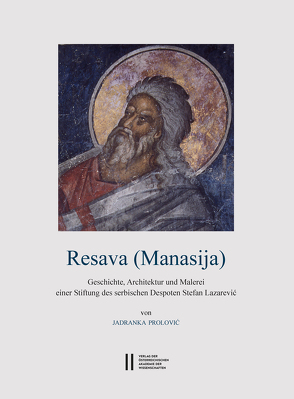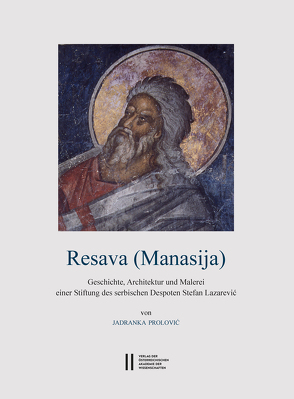Aktualisiert: 2023-05-12
> findR *
Aktualisiert: 2023-05-12
> findR *

This book deals with the Serbian monastery of Resava (also known as Manasija), which is located in the middle of the rich valley of the river Morava, near the town of Despotovac. With the Church of the Holy Trinity, an extraordinary building of the Moravastil, and its fairly well-preserved walls, it is one of the largest, most important and most famous medieval monuments in Serbia.
The monastery is a foundation of the despot Stefan Lazarević (prince 1389–1402, despot 1402–1427), whereby the brilliant church acts as his mausoleum. Begun in 1406/07, the foundation and construction of the monastery reflects the political and cultural circumstances of Serbia, which was situated between Eastern and Western powers (the Ottoman Empire and Hungary). A grandiose fortress was built around the church that conformed to all the rules of a security system as understood then. The structure and frescoes of the complex were completed in 1418; the ceremonious consecration of the monastery took place during the Whitsunday feast of that year. Immediately after its establishment, it became one of the most important spiritual and cultural centers in Serbia. Lively literary activity, which flourished under the learned monks in the monastery, left its stamp on the entirety of Serbian literature. The fortress also played a major role in Serbian history as a defensive bulwark both during the Serbian medieval state and during the Turkocracy and the short period of Austrian rule. The frescos of the church represent one of the final masterpieces of Byzantine art. Stefan’s foundation became famous soon after its completion, and impressed both contemporaries and later visitors with its colorful floor made of marble and serpentine and its gold-decorated frescos.
Aktualisiert: 2023-05-12
> findR *

This book deals with the Serbian monastery of Resava (also known as Manasija), which is located in the middle of the rich valley of the river Morava, near the town of Despotovac. With the Church of the Holy Trinity, an extraordinary building of the Moravastil, and its fairly well-preserved walls, it is one of the largest, most important and most famous medieval monuments in Serbia.
The monastery is a foundation of the despot Stefan Lazarević (prince 1389–1402, despot 1402–1427), whereby the brilliant church acts as his mausoleum. Begun in 1406/07, the foundation and construction of the monastery reflects the political and cultural circumstances of Serbia, which was situated between Eastern and Western powers (the Ottoman Empire and Hungary). A grandiose fortress was built around the church that conformed to all the rules of a security system as understood then. The structure and frescoes of the complex were completed in 1418; the ceremonious consecration of the monastery took place during the Whitsunday feast of that year. Immediately after its establishment, it became one of the most important spiritual and cultural centers in Serbia. Lively literary activity, which flourished under the learned monks in the monastery, left its stamp on the entirety of Serbian literature. The fortress also played a major role in Serbian history as a defensive bulwark both during the Serbian medieval state and during the Turkocracy and the short period of Austrian rule. The frescos of the church represent one of the final masterpieces of Byzantine art. Stefan’s foundation became famous soon after its completion, and impressed both contemporaries and later visitors with its colorful floor made of marble and serpentine and its gold-decorated frescos.
Aktualisiert: 2023-05-12
> findR *

This book deals with the Serbian monastery of Resava (also known as Manasija), which is located in the middle of the rich valley of the river Morava, near the town of Despotovac. With the Church of the Holy Trinity, an extraordinary building of the Moravastil, and its fairly well-preserved walls, it is one of the largest, most important and most famous medieval monuments in Serbia.
The monastery is a foundation of the despot Stefan Lazarević (prince 1389–1402, despot 1402–1427), whereby the brilliant church acts as his mausoleum. Begun in 1406/07, the foundation and construction of the monastery reflects the political and cultural circumstances of Serbia, which was situated between Eastern and Western powers (the Ottoman Empire and Hungary). A grandiose fortress was built around the church that conformed to all the rules of a security system as understood then. The structure and frescoes of the complex were completed in 1418; the ceremonious consecration of the monastery took place during the Whitsunday feast of that year. Immediately after its establishment, it became one of the most important spiritual and cultural centers in Serbia. Lively literary activity, which flourished under the learned monks in the monastery, left its stamp on the entirety of Serbian literature. The fortress also played a major role in Serbian history as a defensive bulwark both during the Serbian medieval state and during the Turkocracy and the short period of Austrian rule. The frescos of the church represent one of the final masterpieces of Byzantine art. Stefan’s foundation became famous soon after its completion, and impressed both contemporaries and later visitors with its colorful floor made of marble and serpentine and its gold-decorated frescos.
Aktualisiert: 2023-02-23
> findR *

This book deals with the Serbian monastery of Resava (also known as Manasija), which is located in the middle of the rich valley of the river Morava, near the town of Despotovac. With the Church of the Holy Trinity, an extraordinary building of the Moravastil, and its fairly well-preserved walls, it is one of the largest, most important and most famous medieval monuments in Serbia.
The monastery is a foundation of the despot Stefan Lazarević (prince 1389–1402, despot 1402–1427), whereby the brilliant church acts as his mausoleum. Begun in 1406/07, the foundation and construction of the monastery reflects the political and cultural circumstances of Serbia, which was situated between Eastern and Western powers (the Ottoman Empire and Hungary). A grandiose fortress was built around the church that conformed to all the rules of a security system as understood then. The structure and frescoes of the complex were completed in 1418; the ceremonious consecration of the monastery took place during the Whitsunday feast of that year. Immediately after its establishment, it became one of the most important spiritual and cultural centers in Serbia. Lively literary activity, which flourished under the learned monks in the monastery, left its stamp on the entirety of Serbian literature. The fortress also played a major role in Serbian history as a defensive bulwark both during the Serbian medieval state and during the Turkocracy and the short period of Austrian rule. The frescos of the church represent one of the final masterpieces of Byzantine art. Stefan’s foundation became famous soon after its completion, and impressed both contemporaries and later visitors with its colorful floor made of marble and serpentine and its gold-decorated frescos.
Aktualisiert: 2023-02-23
> findR *
Aktualisiert: 2023-02-23
> findR *
MEHR ANZEIGEN
Bücher von Prolovic, Jadranka
Sie suchen ein Buch oder Publikation vonProlovic, Jadranka ? Bei Buch findr finden Sie alle Bücher Prolovic, Jadranka.
Entdecken Sie neue Bücher oder Klassiker für Sie selbst oder zum Verschenken. Buch findr hat zahlreiche Bücher
von Prolovic, Jadranka im Sortiment. Nehmen Sie sich Zeit zum Stöbern und finden Sie das passende Buch oder die
Publiketion für Ihr Lesevergnügen oder Ihr Interessensgebiet. Stöbern Sie durch unser Angebot und finden Sie aus
unserer großen Auswahl das Buch, das Ihnen zusagt. Bei Buch findr finden Sie Romane, Ratgeber, wissenschaftliche und
populärwissenschaftliche Bücher uvm. Bestellen Sie Ihr Buch zu Ihrem Thema einfach online und lassen Sie es sich
bequem nach Hause schicken. Wir wünschen Ihnen schöne und entspannte Lesemomente mit Ihrem Buch
von Prolovic, Jadranka .
Prolovic, Jadranka - Große Auswahl an Publikationen bei Buch findr
Bei uns finden Sie Bücher aller beliebter Autoren, Neuerscheinungen, Bestseller genauso wie alte Schätze. Bücher
von Prolovic, Jadranka die Ihre Fantasie anregen und Bücher, die Sie weiterbilden und Ihnen wissenschaftliche Fakten
vermitteln. Ganz nach Ihrem Geschmack ist das passende Buch für Sie dabei. Finden Sie eine große Auswahl Bücher
verschiedenster Genres, Verlage, Schlagworte Genre bei Buchfindr:
Unser Repertoire umfasst Bücher von
- Prolow, Vanessa
- Pröls, Antonia
- Pröls, Christian
- Pröls, Christian
- Pröls, Heidi
- Pröls, Karin
- Pröls, Karin
- Pröls, Reinhard
- Pröls, Wilhelm
- Pröls, Wilhelm
Sie haben viele Möglichkeiten bei Buch findr die passenden Bücher für Ihr Lesevergnügen zu entdecken. Nutzen Sie
unsere Suchfunktionen, um zu stöbern und für Sie interessante Bücher in den unterschiedlichen Genres und Kategorien
zu finden. Neben Büchern von Prolovic, Jadranka und Büchern aus verschiedenen Kategorien finden Sie schnell und
einfach auch eine Auflistung thematisch passender Publikationen. Probieren Sie es aus, legen Sie jetzt los! Ihrem
Lesevergnügen steht nichts im Wege. Nutzen Sie die Vorteile Ihre Bücher online zu kaufen und bekommen Sie die
bestellten Bücher schnell und bequem zugestellt. Nehmen Sie sich die Zeit, online die Bücher Ihrer Wahl anzulesen,
Buchempfehlungen und Rezensionen zu studieren, Informationen zu Autoren zu lesen. Viel Spaß beim Lesen wünscht Ihnen
das Team von Buchfindr.






